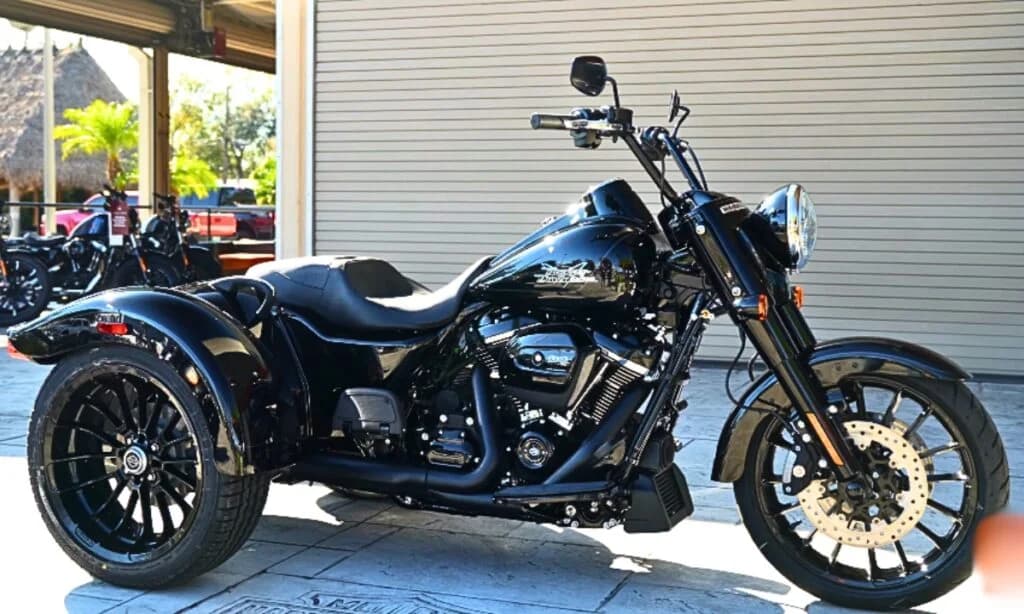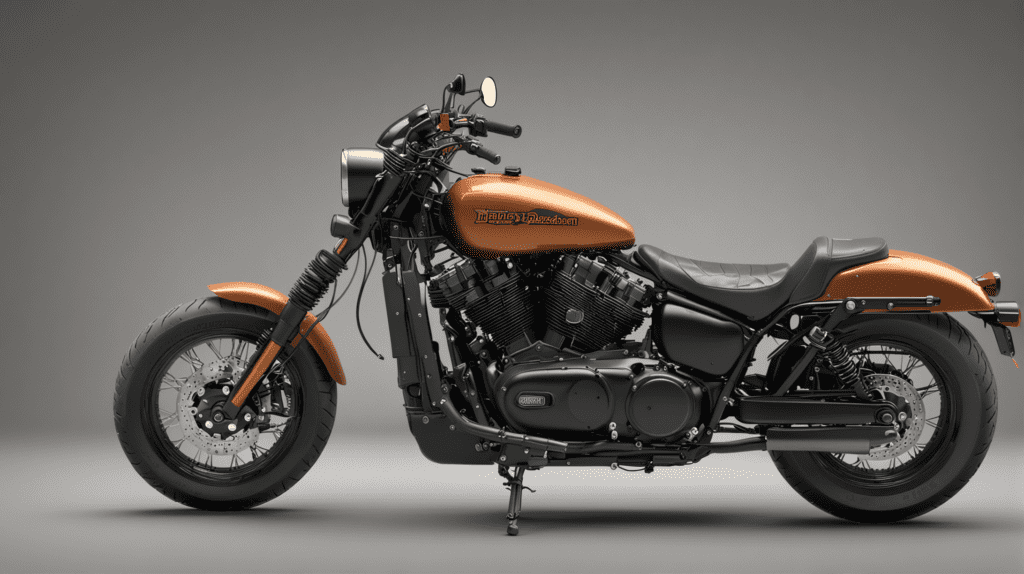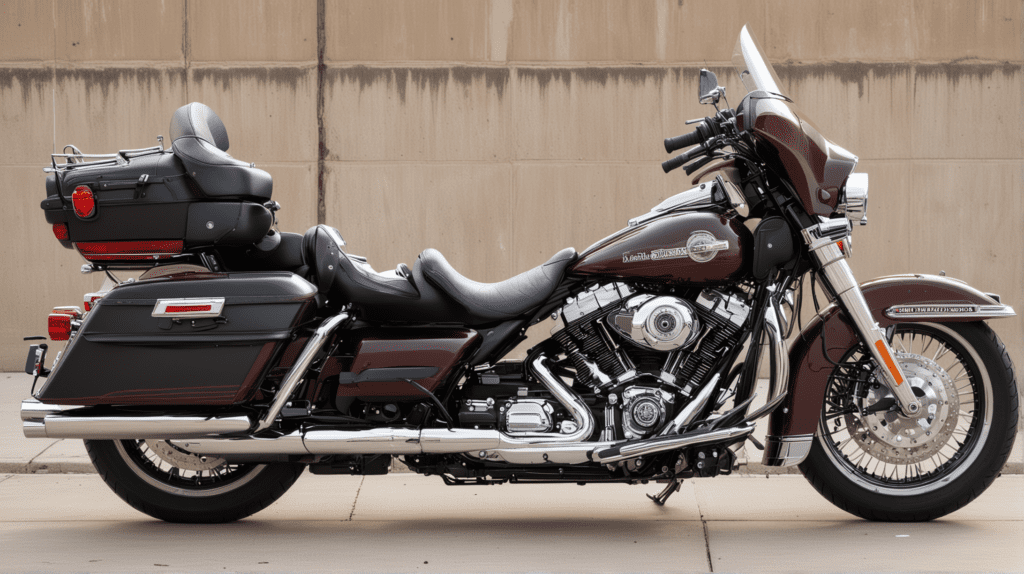The Harley Freewheeler, known for its robust trike design and thrilling open-road experience, embodies the spirit of freedom and adventure.
However, even the most stalwart of bikes may encounter issues that can dampen the riding experience.
In this article, we’ll explore common challenges that Freewheeler owners face with practical solutions.
Harley Freewheeler Problems
Owners have reported issues such as difficulty in handling due to its weight, particularly at low speeds or when maneuvering tight turns.
The absence of a front-end lean that is customary with traditional motorcycles can also detract from the riding experience for some enthusiasts.
Moreover, there have been concerns about the stability control systems and the cost of maintenance and repairs, which tend to be higher for such specialized vehicles.

1. Starting Issues
Starting issues with the Freewheeler range from minor annoyances to significant inconveniences that prevent the motorcycle from operating correctly.
Often, these issues can be traced back to a handful of common culprits.
A depleted or faulty battery, incapable of providing the necessary power to crank the engine, is the most frequent offender.
Electrical connections, including terminals and cables, should be inspected for corrosion or looseness, as these can impede current flow.
The starter motor and solenoid are other critical components that may fail and require testing or replacement.
Fuel system problems, as clogged fuel filters or issues with the fuel injection, can also prevent from starting.
Moreover, the ignition switch and fuses should be checked for functionality, as they can silently fail and disrupt the start-up process.
Lastly, sensor malfunctions like a faulty crank position sensor can cause issues, as they are integral to the engine management system.
To address this issue, begin with a systematic check of the battery’s charge and health, proceed to inspect all electrical connections, test the starter motor and solenoid, and evaluate the fuel system.
If the problem persists, dive into testing the ignition components and sensors.
2. Clutch Problems
Clutch usage is a critical aspect of operating any motorcycle, and improper use can lead to a range of problems.
The clutch system is designed to engage and disengage the engine from the transmission, allowing for smooth gear shifts.
However, issues such as clutch slippage, hard shifting, or complete clutch failure can occur, often stemming from wear and tear or incorrect adjustments.
To ensure optimal function and longevity of your clutch, it is essential to perform regular maintenance checks.
This includes inspecting the clutch cable for tension and lubrication and checking the hydraulic fluid levels.
If your bike has a hydraulic clutch, ensure the clutch plates are not worn down excessively.
If you’re experiencing clutch problems, follow these steps:
- Carefully assess the symptoms, such as difficulty in shifting, unusual noises, or a loose clutch lever feel.
- Visually inspect the clutch cable or hydraulic system, clutch basket, and plates for any signs of wear or damage.
- Adjust the clutch cable or bleed the hydraulic system as needed to ensure proper engagement and disengagement of the clutch.
- If inspection reveals that clutch components are damaged or excessively worn, replace them with quality parts.
- After any adjustments or repairs, perform a test ride in a safe environment to ensure the clutch operates smoothly throughout all gears.
3. Handling Issue
Handling issues can be challenging and dangerous, requiring a methodical approach to diagnose and resolve problems.
To identify the issues, begin by checking for uneven tire wear, which can affect stability and control.
Regular maintenance checks, including tire inspection, alignment verification, and ensuring correct tire pressure, are essential for smooth operation.
Mechanical concerns, such as issues with the steering or suspension system, can also cause issues.
However, for a more comfortable ride, adjustments to the handlebars and seating position might be necessary to suit your ergonomics.
If you are also experiencing vibrations at certain speeds, it’s crucial to check the balance of the wheels and the condition of the bearings.
4. Noise Issues
Harley Freewheelers, known for their distinctive rumble, occasionally suffer from noise issues that can be irritating and an indicator of underlying mechanical concerns.
You may encounter various types of unwanted sounds, such as clicking, knocking, or whining, each pointing to different possible complications.
A clicking sound, particularly evident at low speeds, could signal an issue with the bike’s valves or its chain drive.
To troubleshoot, a valve check and adjustment should be carried out, ensuring they operate within the recommended tolerances.
Knocking noises often stem from the engine and may indicate problems such as detonation or pre-ignition, which can lead to severe engine damage.
Ensuring the use of proper fuel grade and inspecting the spark plugs are essential steps in the diagnosis.
Lastly, a whining sound could be due to transmission issues or a misaligned belt drive.
It’s critical to check the transmission fluid level and quality, which could resolve the problem if found to be low or contaminated.
However, belt tension should be inspected and adjusted according to Harley’s specifications.
5. Overheating
Excessive heat can pose a significant problem in terms of ride comfort and motorcycle performance.
Extended exposure to higher temperatures can lead to engine overheating, which compromises the bike’s mechanics and may result in permanent damage.
To diagnose the issue, you should closely monitor the air-cooled engine temperature, especially during long rides or in stop-and-go traffic.
Upgrading to a high-performance oil or installing an auxiliary cooling system can help mitigate these heat issues.
However, ensuring the coolant levels are maintained, and the radiator is clean and functional is crucial for optimal thermal regulation.
For ride comfort, investing in heat-deflecting accessories and wearing appropriate gear can greatly enhance the experience on hot days.
6. Higher Maintenance
Maintaining a Harley Freewheeler can result in higher than-average costs due to its unique design and specialized parts.
It’s essential to account for expenses beyond routine servicing, such as the frequent changing of the trike-specific tires.
The rear tires, while providing stability, also lead to increased fuel consumption, thereby raising operational costs.
Regular servicing
Standard upkeep includes oil changes, filter changes, and inspections, which should be done every 5,000 miles.
However, the Freewheeler might require more frequent check-ups due to heavy use.
Tire replacement
Trike tires can be more expensive and may need replacing more often than those on two-wheeled motorcycles, especially if you ride frequently or carry heavy loads.
Fuel efficiency
Be prepared for lower fuel efficiency, which means budgeting for increased fuel costs.
Transmission
Specialized care for the transmissions and clutches in trikes is a must, which can be more costly than standard motorcycle care due to their complexity.
Suspension system
Trikes have a complex suspension system to provide stability and comfort, which means potentially higher repair costs compared to traditional bikes.
Brake wear
Trikes have more stopping power and, therefore, can go through brake pads and rotors quickly, especially on the rear wheels.
Insurance
Due to the higher value and specialized nature of trikes like the Freewheeler, insurance costs can be higher. Investing in a good roadside assistance plan is also recommended.
What is The Difference Between a Harley Trike and Freewheeler?
The Harley-Davidson Trike and Freewheeler models epitomize the American motorcycle manufacturer’s foray into three-wheeled bikes, yet they cater to distinct rider preferences.
The Trike, with its full-length body, generous storage capacity, and passenger accommodations, is designed for touring comfort and long-distance adventures.
Conversely, the Freewheeler strips down to the essentials for a hot rod-inspired aesthetic, boasting a shorter wheelbase, reduced weight, and a more aggressive, nimble riding experience.
Both offer the stability of a trike with unique styling and performance characteristics tailored to different riding desires.
Are There Any Specific Models Known For Problems With Harley Freewheeler?
The Harley-Davidson Freewheeler is a popular trike that offers the freedom of motorcycling with added stability.
However, some owners of early models, particularly those of 2015 and 2016, have reported concerns with the rear brakes and clutch system.
There have also been instances of recalls due to manufacturing defects affecting the steering and other components.
What Preventive Can I Take To Avoid Problems With My Harley Freewheeler?
To avoid problems with your Harley Freewheeler, regular maintenance is key.
Ensure that you follow a consistent maintenance schedule that includes checking tire pressure, engine oil levels, and the proper functionality of all lights and signals.
It’s also crucial to inspect the brake system regularly, replacing pads and fluids when necessary.
Keeping the bike clean can prevent rust and corrosion, and using a fuel stabilizer during long periods of inactivity can help maintain the health of the engine.
Remember, always using genuine Harley-Davidson parts for replacements ensures compatibility and longevity of your Freewheeler.
Can I Perform Repairs Tasks on My Harley Freewheeler at home?
Performing repair tasks on a Harley Freewheeler at home is possible if you possess the necessary mechanical skills and tools.
Routine maintenance, as oil changes, brake pad replacements, and battery care, can typically be done in a private garage.
However, tasks that involve engine diagnostics, suspension tuning, or transmission work may require specialized equipment or expertise.
Harley-Davidson also provides a range of service manuals that offer detailed instructions for various maintenance and repair tasks, which can be invaluable resources for DIY enthusiasts.
It’s important to assess one’s skill level and consult the manual before embarking on more complex repairs to ensure personal safety and the integrity of the motorcycle.


Talha Younas, the brains behind the influential motorcycle-focused website, TwoWheller.com, is a dedicated and passionate advocate for biking culture. Born and raised in a family of motorcycle enthusiasts, his love for two-wheeled transportation was ignited at an early age. His commitment to providing in-depth reviews and helpful tips for riders has established him as a respected figure in the motorcycle community.

